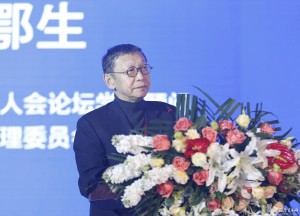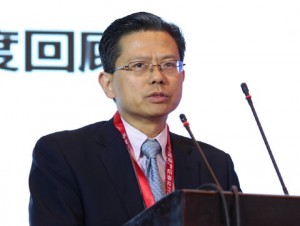China Asset Securitization Annual Meeting
2017-04-09 IMI Liu Yuanchun, vice president of Renmin University, addressed at the annual meeting. Liu said that the current world economy had undergone a qualitative change. First, the world economy is no longer deflated, and monetary policy has shifted in all-round way. The majority of countries, including China, are beginning to enter cycle of raising rate. Second, changes in the operational mode of China's asset securitization exacerbate the asymmetric impact, and the risks are starting to converge along with the shift in currency issuance from traditional funds outstanding for foreign exchange and bank credit to the interbank market. The hidden government debt, capital flight and changes in the interbank market and bond market will further increase the risk caused by the projection of the cycle of raising rate in the coming quarters.
Liu Yuanchun, vice president of Renmin University, addressed at the annual meeting. Liu said that the current world economy had undergone a qualitative change. First, the world economy is no longer deflated, and monetary policy has shifted in all-round way. The majority of countries, including China, are beginning to enter cycle of raising rate. Second, changes in the operational mode of China's asset securitization exacerbate the asymmetric impact, and the risks are starting to converge along with the shift in currency issuance from traditional funds outstanding for foreign exchange and bank credit to the interbank market. The hidden government debt, capital flight and changes in the interbank market and bond market will further increase the risk caused by the projection of the cycle of raising rate in the coming quarters.
 Ma Delun, member of IMI Advisory Board, chairman of Banking Accounting Society of China, and the former deputy governor of PBoC, delivered a keynote speech. He said that as the financial sector became market-oriented, international and technology-based, asset securitization gains strength. Asset securitization, as a new financial tool, is being recognized and accepted from all aspects, and the growth rate and development scale of asset securitization in recent years has proved that. For asset securitization, from the basic assets to the asset pool, from pricing to sales, from the original equity to investors, the formation of a complete industrial chain and thoughtful service will undoubtedly make the asset securitization market more mature, and thus more efficient.
Ma Delun, member of IMI Advisory Board, chairman of Banking Accounting Society of China, and the former deputy governor of PBoC, delivered a keynote speech. He said that as the financial sector became market-oriented, international and technology-based, asset securitization gains strength. Asset securitization, as a new financial tool, is being recognized and accepted from all aspects, and the growth rate and development scale of asset securitization in recent years has proved that. For asset securitization, from the basic assets to the asset pool, from pricing to sales, from the original equity to investors, the formation of a complete industrial chain and thoughtful service will undoubtedly make the asset securitization market more mature, and thus more efficient.
 Cai Esheng, the former deputy chairman of CBRC, gave advice on product innovation for financial institutions in the keynote speech. To implement asset securitization business in China, Cai Esheng put forward ten measures, emphasizing that “financial institutions, while making product innovation to meet the public demand in accordance with the overall requirements of the reform, should specially focus on maintaining stable performance and improving the product.” He said, from institution’s senior officials to the community-level officials, they can only truly grasp the concept of financial products and their service role when they develop the correct concept, and then they can better promote the products.
Cai Esheng, the former deputy chairman of CBRC, gave advice on product innovation for financial institutions in the keynote speech. To implement asset securitization business in China, Cai Esheng put forward ten measures, emphasizing that “financial institutions, while making product innovation to meet the public demand in accordance with the overall requirements of the reform, should specially focus on maintaining stable performance and improving the product.” He said, from institution’s senior officials to the community-level officials, they can only truly grasp the concept of financial products and their service role when they develop the correct concept, and then they can better promote the products.
 Chen Lei, president of XFintech, reviewed in the keynote speech the 2016 asset securitization market. He said that the asset securitization business in 2016 not only achieved breakthroughs in scale, but also in variety of basic assets. We also developed new ways of innovating policy, improving supervision, developing market, upgrading product structure and increasing product type and so on. But he also pointed out that the separate regulatory system, too much institutions participation, inefficient issuance, and investors focusing on credit risk and neglecting basic asset risk, all these hold back the development of the market.
Chen Lei, president of XFintech, reviewed in the keynote speech the 2016 asset securitization market. He said that the asset securitization business in 2016 not only achieved breakthroughs in scale, but also in variety of basic assets. We also developed new ways of innovating policy, improving supervision, developing market, upgrading product structure and increasing product type and so on. But he also pointed out that the separate regulatory system, too much institutions participation, inefficient issuance, and investors focusing on credit risk and neglecting basic asset risk, all these hold back the development of the market.
 Cao Tong, IMI co-director, chairman of XFintech, and founder of Guo Jin ABS Cloud, concludes that in the current economic cycle, it is of great significance to develop asset securitization. Cao elaborated three ways: first, the market construction; second, the policy support; third, the social support.
Cao Tong, IMI co-director, chairman of XFintech, and founder of Guo Jin ABS Cloud, concludes that in the current economic cycle, it is of great significance to develop asset securitization. Cao elaborated three ways: first, the market construction; second, the policy support; third, the social support.

